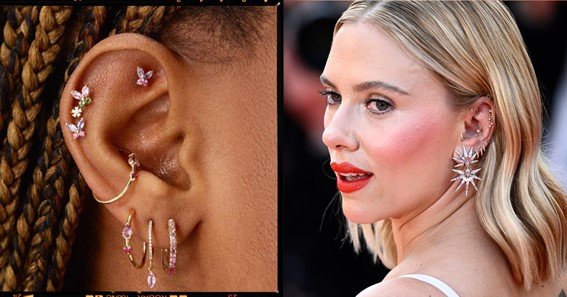The world of ear piercings is diverse and creative, offering endless possibilities for self-expression. Whether you’re a first-timer or a piercing enthusiast, understanding the different types of ear piercings and their placements can help you make informed decisions.
The ear piercings chart is a useful tool that provides a clear visualization of the various spots you can pierce, from the classic lobe to intricate cartilage piercings.
What is an Ear Piercings Chart?
An ear piercings chart is a visual guide that showcases the different types of ear piercings and their placements. It helps you understand the location, pain levels, healing times, and suitable jewelry for each type of piercing.
This chart is especially useful for those planning multiple piercings, as it allows you to map out your piercings for a cohesive and stylish look.
Types of Ear Piercings
- Lobe Piercing: The most common type of ear piercing, placed on the soft lower part of the earlobe. It’s one of the least painful piercings and heals relatively quickly within 6-8 weeks.
- Helix Piercing: Located on the upper cartilage of the ear, this piercing can be done in multiple spots along the ear’s rim. Healing time ranges from 6-12 months, and it is more painful than lobe piercings due to the cartilage.
- Tragus Piercing: This piercing is done on the small piece of cartilage that covers the ear canal. While it’s not the most painful, it can be inconvenient when using earphones.
- Daith Piercing: A trendy piercing located in the innermost fold of the ear. It’s believed by some to help reduce migraines.
- Conch Piercing: This piercing is placed in the large cup-shaped area of the ear’s cartilage, allowing for studs or cuffs. It is more painful due to the thicker cartilage.
- Industrial Piercing: Involves two piercings connected by a single piece of jewelry, usually a barbell. This piercing is quite painful and requires a longer healing period.
Aftercare for Ear Piercings
Proper aftercare is crucial for ensuring that your ear piercings heal without infection or complications. Here are some basic tips:
- Clean Regularly: Use saline solution or an aftercare product recommended by your piercer to clean the area twice a day.
- Avoid Touching: Refrain from touching or twisting your piercing, as this can cause irritation or introduce bacteria.
- Patience with Healing: Cartilage piercings, in particular, take longer to heal, ranging from 6-12 months depending on the type.
FAQ
1. What is the least painful ear piercing?
Lobe piercings are typically the least painful as they go through soft tissue with minimal nerve endings.
2. How long do ear piercings take to heal?
Healing times vary: lobes heal in 6-8 weeks, while cartilage piercings like helix or conch can take 6-12 months.
3. What type of jewelry is best for new ear piercings?
For new piercings, studs made from surgical steel, titanium, or gold are ideal because they are hypoallergenic and safe for healing.
4. Can I combine different types of ear piercings?
Yes, combining piercings such as lobes, helix, and tragus can create a stylish “ear constellation.” Just ensure you space them properly for healing.
5. Do cartilage piercings hurt more than lobe piercings?
Yes, cartilage piercings tend to be more painful due to the tougher tissue, and they also take longer to heal compared to lobe piercings.
Understanding the various types of ear piercings and planning with the help of a detailed ear piercings chart will allow you to create a unique, stylish look while minimizing discomfort and complications.










